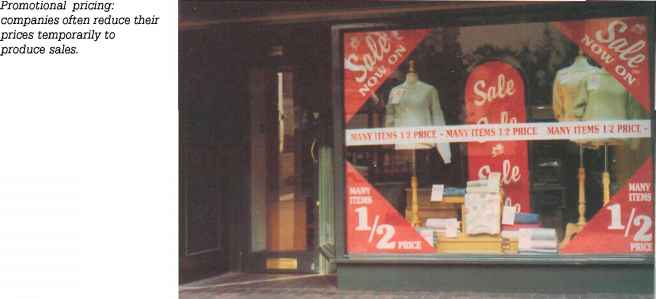Discount and Allowance Pricing
Most companies adjust their basic price to reward customers for certain responses, such as early payment of bills, volume purchases and off-season buying. These price adjustments - called discounts and allowances - can take many forms.
A cash discount is a price reduction to buyers who pay their bills promptly, A typical example is '2/10, net 30'. which means that although payment is due within 30 days, the buyer can deduct 2 per cent if the hill is paid within 10 days. The discount must be granted to all buyers meeting these terms. Such discounts are customary in many industries and help to improve the sellers' cash situation and reduce bad debts and credit-collection costs.
A quantity discount is a price reduction to buyers who buy large volumes. A typical example might be 'K10 per unit for less than 100 units, $9 per unit for 100 or more units'. Wine merchants often give 'twelve for the price of eleven' and Makro, the trade warehouse, automatically gives discounts on any product bought in bulk. Discounts provide an incentive to the customer to buy more from one given seller, rather than from many different sources.
cash discount A price reduction to buyers -teho pay their bills promptly.
quantity discount A price reduction to buyers who buy targe -volumes.

quantity premium A swre/iarge paid try (wyers who purchase high volumes of a product.
functional discount (trade discount) A price reduction offered by [he seller to trade channel members that perform certain functions, such as selling, storing and record keeping.
seasonal discount A price reduction to buyers who buy merchandise or services out of season.
trade-ill allowance A price reduction given for turning in an old item when buying a new one.
promotional allowance A payment or price reduction to reward dealers for particapting in advertising and sales-support programmes.
A quantity premium is sometimes charged to people buying higher volumes. In Japan it often costs more per item to buy a twelve-pack of beer or sushi than smaller quantities because the larger packs are more gift able and therefore less price sensitive. Quantity surcharges can also oecur when die product being bought is in short supply or in sets - for example, several seats together at a 'sold-out' rock concert or sports event - and some small restaurants charge a premium to large groups. Similarly, in buying antiques, it costs more to buy six complete place settings of cutlery than a single item. In this case the price will continue to increase with volume, eight place settings costing more than six, and twelve place settings costing more than eight. Quantity premiums are more common than people imagine, and that is why they work. Consumers expect prices to deerease with volume and so do not check unit prices. This allows retailers to slip in high-margin items. Quantity surcharge increases with the variety and complexity of pack sizes and, in some markets, over 30 per cent of ranges include some quantity surcharging.11
A trade discount (also called a functional discount) is offered by the seller to trade channel members that perform certain functions, such as selling, storing and record keeping. Manufacturers may offer different functional discounts to different trade channels because of the varying services they perform, but manufacturers must offer the same functional discounts within each trade channel.
A seasonal discount is a price discount to buyers who buy merchandise or services out of season. For example, lawn and garden equipment manufacturers will offer seasonal discounts to retailers during the autumn and winter to encourage early ordering in anticipation of the heavy spring and summer selling seasons. Hotels, motels and airlines will offer seasonal discounts in their slower selling periods. Seasonal discounts allow the seller to keep production steady during the entire year.
Allowances are another type of reduction from the list price. For example, trade-in allowances are price reductions given for turning in an old item when buying a new one. Trade-in allowances are most common in the car industry, but are also given for other durable goods. Promotional allowances are payments or price reductions to reward dealers for participating in advertising and sales-support programmes.
Continue reading here: Segmented Pricing
Was this article helpful?
Readers' Questions
-
ronald ball7 months ago
- Reply
-
Bisirat1 year ago
- Reply
-
biniam1 year ago
- Reply
-
thorsten1 year ago
- Reply
-
kenneth1 year ago
- Reply
-
thomas1 year ago
- Reply
-
anthony1 year ago
- Reply
-
nereo palermo1 year ago
- Reply